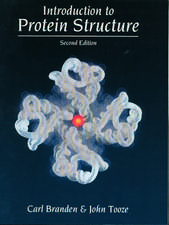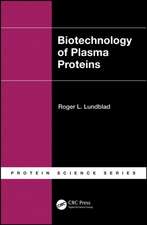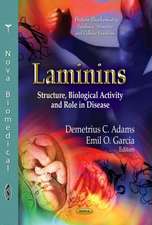Encyclopedia of Metalloproteins
Editat de Robert H. Kretsinger, Vladimir N. Uversky, Eugene A. Permyakoven Limba Engleză Hardback – 30 apr 2013
Metalloproteins deals with all aspects related to the intracellular and extracellular metal-binding proteins, including their structures, properties and functions. The biological roles of metal cations and metal-binding proteins are endless. They are involved in all crucial cellular activities. Many pathological conditions are related to the problematic metal metabolism.
Research in metalloprotein-related topics is therefore rapidly growing, and different aspects of metal-binding proteins progressively enter curricula at Universities andeven at the High School level on occasion. However, no key resource providing basic, but comprehensible knowledge on this rapidly expanding field exists. The Encyclopedia of Metalloproteins aims to bridge this gap, and will attempt to cover various aspects of metalloprotein/metalloproteomics and will deal with the different issues related to the intracellular and extracellular metal-binding proteins, including their structures, properties and functions. The goal is to cover exhaustively all catalytically and biologically crucial metal ions and to find at least one interacting protein for other metal ions. The Encyclopedia of Metalloproteins will provide a key resource for advanced undergraduate and graduate students, researchers, instructors, and professors interested in protein science, biochemistry, cell biology, and genetics.
Preț: 2899.51 lei
Preț vechi: 3815.15 lei
-24% Nou
Puncte Express: 4349
Preț estimativ în valută:
554.100€ • 603.05$ • 466.50£
554.100€ • 603.05$ • 466.50£
Carte tipărită la comandă
Livrare economică 16-22 aprilie
Preluare comenzi: 021 569.72.76
Specificații
ISBN-13: 9781461415329
ISBN-10: 1461415322
Pagini: 2800
Ilustrații: LVII, 2574 p. 1108 illus., 777 illus. in color. In 4 volumes, not available separately.
Dimensiuni: 193 x 260 x 159 mm
Greutate: 6.37 kg
Ediția:2013
Editura: Springer
Colecția Springer
Locul publicării:New York, NY, United States
ISBN-10: 1461415322
Pagini: 2800
Ilustrații: LVII, 2574 p. 1108 illus., 777 illus. in color. In 4 volumes, not available separately.
Dimensiuni: 193 x 260 x 159 mm
Greutate: 6.37 kg
Ediția:2013
Editura: Springer
Colecția Springer
Locul publicării:New York, NY, United States
Public țintă
ResearchCuprins
Period 2: Lithium, Beryllium.- Period 3: Sodium, Magnesium, Aluminium.- Period 4: Potassium, Calcium, Scandium, Titanium, Vanadium, Chromium, Manganese, Iron, Cobalt, Nickel, Copper, Zinc, Gallium.- Period 5: Rubidium, Strontium, Yttrium, Zirconium, Niobium, Molybdenum, Technetium, Ruthenium, Rhodium, Palladium, Silver, Cadmium, Indium, Tin.- Period 6: Caesium, Barium, Lanthaninds (Lanthanum, Cerium, Praseodymium, Neodymium, Promethium, Samarium, Europium, Gadolinium, Terbium, Dysprosium, Holmium, Erbium, Thulium, Ytterbium), Lutetium, Hafnium, Tantalum, Wolfram, Rhenium, Osmium, Iridium, Platinum, Gold, Mercury, Thallium, Lead, Bismuth.- Period 7: Francium, Radium, Actinides (Actinium, Thorium, Protactinium, Uranium).
Notă biografică
Robert H. Kretsinger is a Professor of Biology at the University of Virginia. He earned is Ph.D. in Biophysics from the Massachusettes Institute of Technology in 1964, and his current research focuses on how to better understand how the genome guides physiology, with specific research interests including protein structure determination, annexin, protein kinase C (PKC), and 3-deoxy-D-arabino-heptulosonate-7-phosphate synthase (DAHPS).Vladimir Uversky earned his Ph.D. in Biophysics from the Moscow Institute of Physics and Technology in 1991, and is currently an Associate Professor in University of South Florida's College of Medicine. His research focuses primarily on the phenomenon of protein intrinsic disorder.Eugene A. Permyakov earned his Ph.D. in Physics and Mathematics at the Moscow Institute of Physics and Technology in 1976. Since then, he has worked at the Institute of Theoretical and Experimental Bio-physics of the Russian Academy of Sciences, and is currently the Director of the Institute for Biological Instrumentation of the Russian Academy of Sciences. Permyakov is best known for his research on metal binding proteins and the intrinsic fluorescence method, with primary research interests focused on the study of physico-chemical and functional properties of metal binding proteins.
Caracteristici
Covers various aspects of metalloprotein/ metalloproteomics, dealing with the different issues related to the intracellular and extracellular metal-binding proteins, including their structures, properties and functions Exhaustively reviews all catalytically and biologically crucial metal ions and to find at least one interacting protein for other metal ions Provides a key resource for advanced undergraduate and graduate students, researchers, instructors, and professors interested in protein-science, biochemistry, cell biology, and genetics













